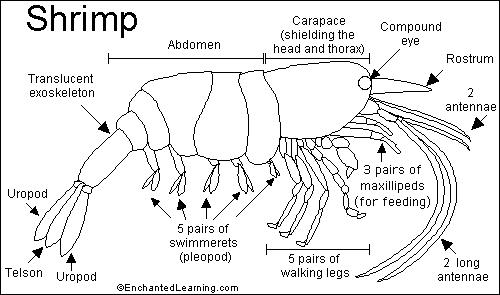
 |
| You might also like: | Crustaceans to Color Online | Copepod Printout | Animal Pages to Color Online - List - AllAboutNature.com | Great Blue Heron Printout | Crane Printout | Today's featured page: Three Blind Mice Printout |
| EnchantedLearning.com | Shrimp | Animal Printouts Label Me! Printouts |


Anatomy: Shrimp range from a small fraction of an inch to 9 inches (a few mm to 23 cm) long. These crustaceans have a thin, smooth, hard, and almost transparent exoskeleton. Shrimp vary widely in color; tropical varieties are often brightly colored. Shrimp have 5 pairs of jointed walking legs on the thorax, and they have 5 pairs of swimming legs (swimmerets) and 3 pairs of maxillae (feeding appendages) on the abdomen. The body, legs, swimmerets, and other appendages are segmented. Shrimp have two pairs of segmented sensory antennae, a tail fan, and compound eyes.
Diet: Shrimp are omnivores; they eat plants and small animals. The unusual pistol shrimp kills or stuns its prey by making a very loud sound with a huge claw with a moveable, snapping appendage.
Life Cycle: Female shrimp lay over a thousand eggs, which are attached to her swimming legs. The shrimp emerge as tiny, floating organisms, a component of zooplankton. After growing, they sink to the bottom, where they will live. As a shrimp grows, it often molts (losing its old shell and growing a new one).
Predators: Shrimp are eaten by many animals, including many fish, many birds (including flamingos and loons), octopi, squid, cuttlefish, and people.
Classification: Kingdom Animalia, Phylum Arthropoda, Class Crustacea (crustaceans), Subclass Malacostraca, Order Decapoda, Suborder Natantia.
| Search the Enchanted Learning website for: |